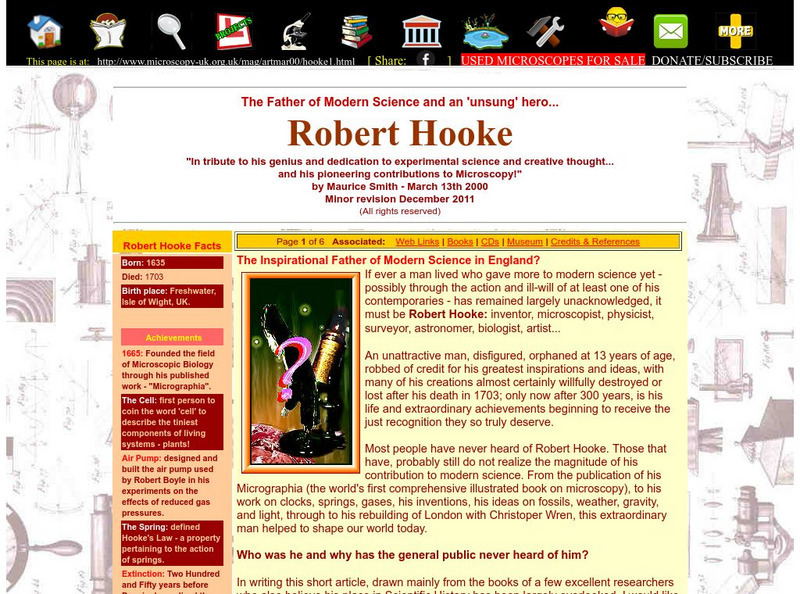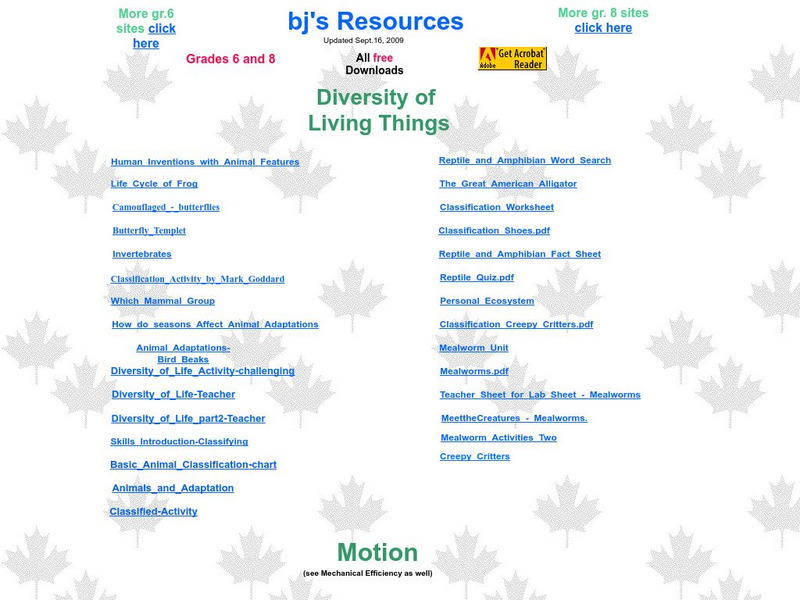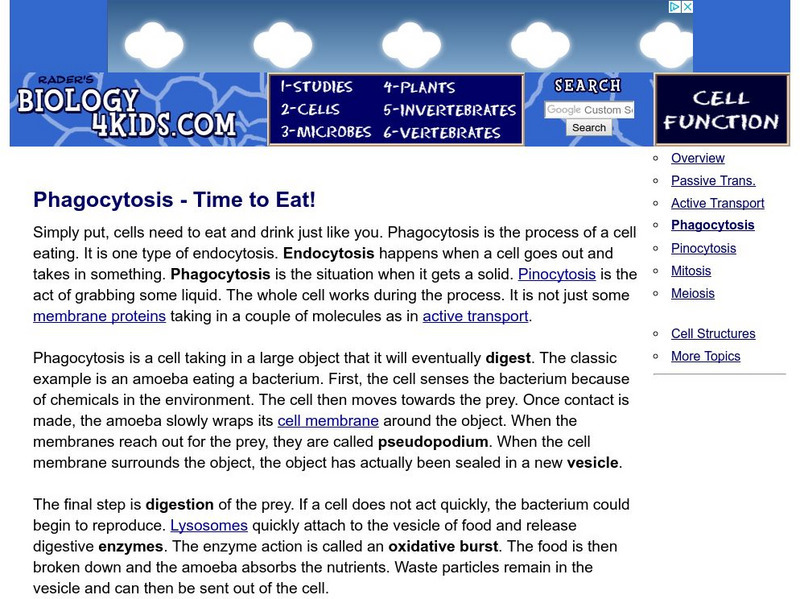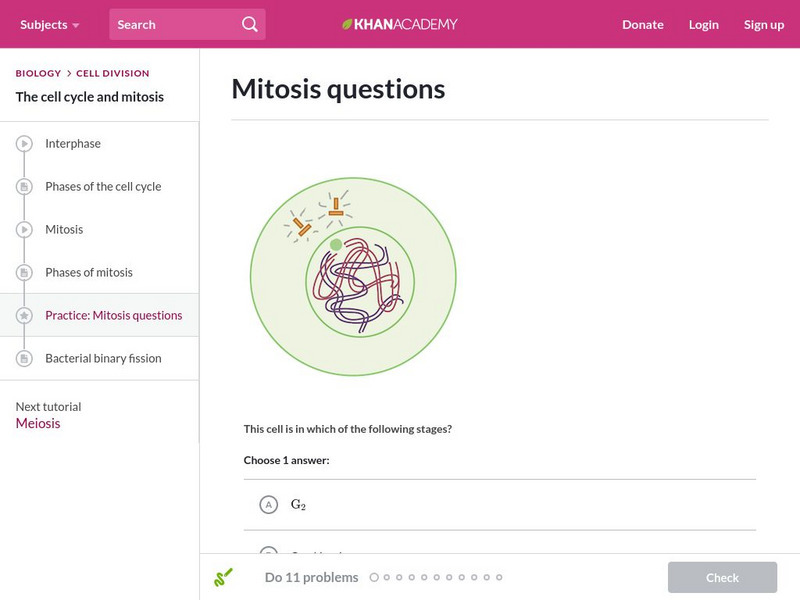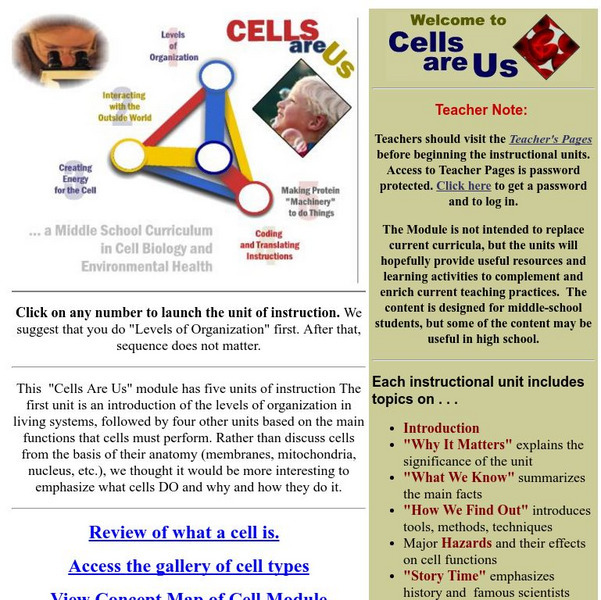Microscopy UK
Microscopy Uk: Robert Hooke the Father of Modern Science
An excellent review of this important man in science who went unnoticed for so many years.
My Science Site
Life Systems: Cells, Tissues, Organs
Extensive site for teachers provides some helpful resources that pertain to plant and animal cells. Includes a microscope diagram as well as plant, animal and pond labs. Also contains links to structures and mechanisms, matter and...
The Franklin Institute
Franklin Institute Science Museum: Plastids
Bulleted info on chloroplasts, chromoplasts and leukoplasts.
Alabama Learning Exchange
Alex: Edible Cell
As part of the study on Life Processes, the students will watch a video clip at Cells Alive to see a model of the cell and its components. The students will use edible products to create an animal cell. Each product will represent a...
Alabama Learning Exchange
Alex: Inside the Cell
In this lesson, students learn the different kinds of cells including plant and animal cells. They also learn how to identify and name the organelles of eukaryotic cells.
PBS
Pbs Teachers: Changing Your Mind: Increasing Brainpower
Investigate the brain and it's connections - the number of possible routes along which a brain message might travel - by solving and creating geometric progressions. Conduct an experiment to learn about stimulus and response.
University of Missouri
Oklahoma State University Biotech Adventure: Animal Cell
Follow this link to a clearly labeled diagram of an animal cell. Includes written descriptions of all the parts of the cell.
Biology 4 kids
Biology4 Kids: Phagocytosis Time to Eat!
Find out about the cellular process of phagocytosis, and its role in the body's immune system.
Sophia Learning
Sophia: 7 Characteristics of Life: Lesson 2
This lesson will introduce the 7 characteristics of all living things. It is 2 of 4 in the series titled "7 Characteristics of Life."
Khan Academy
Khan Academy: Mitosis Questions
Use these questions to check your understanding of mitosis.
CPALMS
Florida State University Cpalms: Florida Students: Levels of Organization
FSERL: Explanation of the hierarchical levels of living things.
CK-12 Foundation
Ck 12: Earth Science: Evolution of Simple Cells
[Free Registration/Login may be required to access all resource tools.] How simple cells evolved.
CK-12 Foundation
Ck 12: Earth Science: Evolution of Simple Cells
[Free Registration/Login may be required to access all resource tools.] How simple cells evolved.
Biology 4 kids
Biology4 Kids: Cell Structure
Informational, illustrated site covers the basics of cell structures and various cell types.
Read Works
Read Works: Famous Scientists Robert Hooke
[Free Registration/Login Required] This passage contains a short biography of Robert Hooke, his development of a microscope, and his discovery of cells. he developed. This passage is a stand-alone curricular piece that reinforces...
Read Works
Read Works: The Cells That Make Us
[Free Registration/Login Required] A literary text about a boy who skins his knee and then learns all about cells and how they work to form living things. A question sheet is available to help students build skills in reading comprehension.
CK-12 Foundation
Ck 12: Life Science: Organization of the Human Body
[Free Registration/Login may be required to access all resource tools.] Cells, like these nerve cells, do not work in isolation. To send orders from your brain to your legs, for example, signals pass through many nerve cells. These cells...
Soft Schools
Soft Schools: Biology Quizzes: Cell Structure and Function
Assess your understanding of cells and their function with this interactive multiple choice quiz. Immediate feedback is provided.
Estrella Mountain Community College
Estrella Mountain College: Cell Division and Meiosis
Resource provides a holistic and complete meiosis lesson with illustrations, animations, glossary, and links. Extremely detailed and helpful site.
Cells Alive
Cells Alive!
Animation studio that specializes in medical illustration lets you explore the structure and function of plant cells and animal cells, using videos and interactive graphics with clickable parts that lead to more detail.
OpenStax
Open Stax: Structural Organization of the Human Body
Try considering the structures of the body in terms of fundamental levels of organization that increase in complexity: subatomic particles, atoms, molecules, organelles, cells, tissues, organs, organ systems, organisms and biosphere....
Texas A&M University
Peer Curricula: Cells Are Us
Find five instructional units on cells: levels of organization, interacting with the outside world, creating energy for the cell, coding and translating instructions, and making protein "machinery" to do things. Each unit is broken down...
CommonLit
Common Lit: Things Get More Complicated When You're Older
A learning module that begins with "Things Get More Complicated When You're Older" by BirdBrain Science, accompanied by guided reading questions, assessment questions, and discussion questions. The text can be printed as a PDF or...


